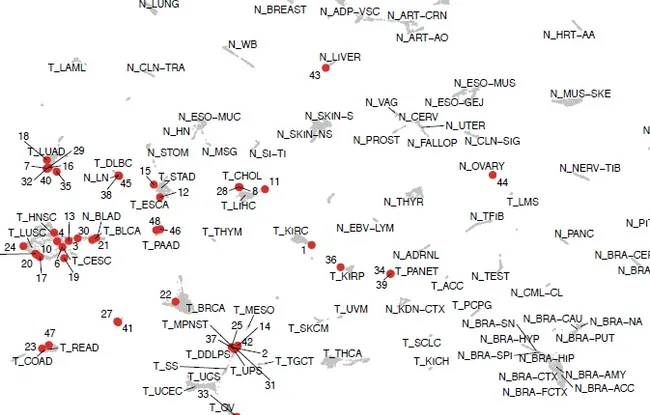- Home >
- Institut Curie News >
- Institut Curie is developing an artificial intelligence tool for diagnosing cancer of un-known primary
Cancer “of unknown primary” and “of unknown origin” refers to cancer that is discovered due to the presence of metastases, meaning when the illness has spread to other tissues, whereas the initial affected organ cannot be identified. This type of cancer accounts for 2 to 3% of all cancer cases (approximately 7,000 patients per year in France), and is particularly challenging to treat: because it is diagnosed at an advanced stage, and because the primary site of the cancer is unknown, it is impossible to pinpoint the most effective treatment to be used.
Until now, doctors were ill-equipped to determine the site where these metastases originated: they would run comprehensive medical imaging of the entire body using a scanner and PET scan, conduct detailed analysis via microscope (anatomic-pathology) of samples of these metastases on the lookout for clues as to their origin, and more recently, would draw on molecular biology to spot mutations, particular genetic features that would point to a given organ. Despite this, these tumors’ original tissue would remain unknown in a great many cases, and patients would be treated via non-specific broad-spectrum chemotherapy.
Lots of research teams have looked at this issue
Says Institut Curie researcher and medical oncologist Sarah Watson.
And many have attempted to identify these tumors’ molecular signatures.
But these are often difficult to replicate, require specialist equipment, and most significantly of all, have not resulted in an increase in survival rates among patients with these types of cancer.
The Institut Curie approach offers something different.
Rather than simply analyzing a couple of dozen genes, we used the next-generation RNAsequencing technique to sequence all genes expressed in a tumor, in order to draw up a diagnostic classifier based on expression profiles of over 20,000 tumors and normal tissues. We developed a deep-learning algorithm that learnt to successfully match a given RNA profile to a specific organ or tissue, whether cancerous or not
Explains Sarah Watson.
The Institut Curie team then ran RNAseq data from 48 tumors of unknown primary through this computer program. In 79% of cases, the algorithm was able to identify the original tissue. In 11 newly-diagnosed patients, eight were given treatment based on these findings, and all saw positive results from this treatment. Following this promising study’s publication in the Journal of Molecular Diagnostics, Institut Curie is now seeking to build awareness and encourage application of this method in a greater number of care and treatment establishments through its involvement in France’s Multidisciplinary Tumor Board (Réunion de Concertation Pluridisciplinaire, RCP), an event given over to these unknown-primary cancers, and through France Médecine Génomique 2025, a program that aims to create two initial diagnostics and therapeutic follow-up genomics platforms using high-throughput human genome sequencing.
|
Identification of tissue of origin and guided therapeutic applications in cancers of unknown primary using deep learning and RNA sequencing (TransCUPtomics), Journal of Molecular Diagnostics |
Research News
Discover all our news
Celebration
The Immunity and Cancer research unit (U932) celebrates its twentieth anniversary
12/12/2025
Artificial Intelligence
08/12/2025


